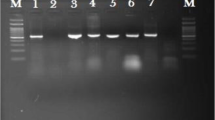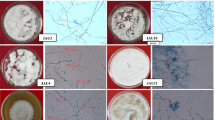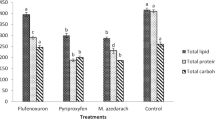Abstract
Formosan subterranean termites (FST) were exposed to strains of Beauveria pseudobassiana (Bpb) and Isaria fumosorosea (Ifr) to determine virulence of the fungi. Once lethality was determined, sublethal doses of Bpb were combined with enzymes capable of degrading the insect cuticle to measure the potential to enhance fungal infection. Bpb applied to FST in combination with proteinases and a chitinase caused increased mortality over the fungus alone. Mortality was enhanced when Ifr was applied to FST in combination with a chitinase isolated from Serratia marcesans. A lipase isolated from Pseudomonas cepacia, when combined with Ifr, also resulted in greater mortality than all control treatments. FST were also exposed to the eicosanoid biosynthesis inhibitors (EBIs) dexamethasone (DEX), ibuprofen (IBU), and ibuprofen sodium salt (IBUNA), in combination with Ifr. Combining Ifr with IBUNA caused significantly increased mortality on days 6, 7, and 9. Cuticle-degrading enzymes and EBIs may have potential to enhance the pathogenic effect of a fungal control agent against the Formosan subterranean termite.








Similar content being viewed by others
References
Bulmer MS, Bachelet I, Raman R, Rosengaus RB, Sasisekharan R (2009) Targeting an antimicrobial effector function in insect immunity as a pest control strategy. PNAS 106(31):12652–12657
Chouvenc T, Su NY, Grace JK (2011) Fifty years of attempted biological control of termites—analysis of a failure. Biol Cont 59:69–82
Cody RP, Smith JK (1997) Applied statistics and the SAS programming language, 4th edn. Prentice-Hall, Inc., Upper Saddle River
Connick WJ Jr, Osbrink WLA, Wright MS, Williams KS, Daigle DJ, Boykin DL, Lax AR (2001) Increased mortality of Coptotermes formosanus (Isoptera: Rhinotermitidae) exposed to eicosanoid biosynthesis inhibitors and Serratia marcesans (Eubacteriales: Enterobacteriaceae). Environ Entomol 30(2):449–455
Dahiya N, Tewari R, Hoondal GS (2006) Biotechnological aspects of chitinolytic enzymes: a review. Appl Microbio and Biotech 71:773–782
Dunlap CA, Jackson MA, Wright MS (2007) A foam formulation of Paecilomyces fumosoroseus, an entomopathogenic biocontrol agent. Biocontrol Sci and Technol 17:513–523
El-Sayed GN, Coudron TA, Ignoffo CM, Riba G (1989) Chitinolytic activity and virulence associated with native and mutant isolates of an entomopathogenic fungus Nomuraea rileyi. J Invert Pathol 54:394–403
Ghikas DV, Kouvelis VN, Typas MA (2010) Phylogenetic and biogeographic implications inferred by mitochondrial intergenic region analyses and ITS1-5.8S-ITS2 of the entomopathogenic fungi Beauveria bassiana and B. brogniartii. BMC Microbiol 10:174–189
Gupta SC, Leathers TD, El-Sayed GN, Ignoffo CM (1994) Relationships among enzyme activities and virulence parameters in Beauveria bassiana infections of Galleria mellonella and Trichoplusia ni. J Invert Pathol 64:13–17
Hegedus DD, Khachatourians GG (1988) Production of an extracellular lipase by Beauveria bassiana. Biotech Lett 10:637–642
Hernandez-Torres I, Iracheta M, Galan-Wong LJ, Hernandez C, Contreras J, Jackson M, Pereyra-Alferez B (2004) A Paecilomyces fumosoroseus mutant over-producing chitinase displays enhanced virulence against Bemisia tabaci. World J Microbiol Biotech 20:207–210
Howard RW, Miller JS, Stanley DW (1998) The influence of bacterial species and intensity of infections on nodule formation in insects. J Insect Physiol 44:157–164
Jackson MA (1999) Method for producing dessication tolerant Paecilomyces fumosoroseus spores. US Patent 5:968,808
Jackson MA, Cliquet S, Iten LB (2003) Media and fermentation processes for the rapid production of high concentrations of stable blastospores of the bioinsecticidal fungus Paecilomyces fumosoroseus. Biocontrol Sci and Technol 13:23–33
Jackson MA, McGuire MR, Lacey LA, Wraight SP (1997) Liquid culture production of desiccation tolerant blastospores of the bioinsecticidal fungus Paecilomyces fumosoroseus. Mycol Res 101:35–41
Karasuda S, Tanaka S, Kajihara H, Yamamoto Y, Koga D (2003) Plant chitinase as a possible biocontrol agent for use instead of chemical fungicides. Biosci Biotech and Biochem 67:221–224
Khan A, Williams K, Molloy MP, Nevalainen H (2003) Purification and characterization of a serine protease and chitinases from Paecilomyces lilacinus and detection of chitinase activity on 2D gels. Prot Express and Purif 32:210–220
Luangsa-Ard JJ, Hywel-Jones NL, Manoch L, Samson RA (2005) On there lationships of Paecilomyces sect. Isarioidea species. Mycol Res 109:581–589
Mendonsa ES, Vartak PH, Rao JU, Deshpande MV (1996) An enzyme from Myrothecium verrucaria that degrades insect cuticles for biocontrol of Aedes aegypti mosquito. Biotechnol Lett 18:373–376
Miller JS, Nguyen T, Stanley-Samuelson DW (1994) Eicosanoids mediate insect nodulation responses to bacterial infections. Proc Nat Acad Sci USA 91:12418–12422
Miller JS, Howard W, Nguyen T, Nguyen A, Rosario RMT, Stanley-Samuelson DW (1996) Eicosanoids mediate nodulation responses to bacterial infections in larvae of the tenebrionid beetle, Zophobas atratus. J Insect Phys 42:3–12
Miller JS, Howard RW, Rana RL, Tunaz H, Stanley DW (1999) Eicosanoids mediate nodulation reactions to bacterial infections in adults of the cricket, Gryllus assimilis. J Insect Phys 45:75–83
Nahar P, Ghormade V, Deshpande MV (2004) The extracellular production of chitin deacetylase in Metarhizium anisopliae: possible edge to entomopathogenic fungi in the biological control of insect pests. J Invert Pathol 85:80–88
Rehner SA, Buckley E (2005) A Beauveria phylogeny inferred from nuclear ITS and EF1-α sequences: evidence for cryptic diversification and links to Cordyceps teleomorphs. Mycologia 97:84–98
Shimizu S, Yamaji M (2002) Pathogenicity of entomopathogenic fungi to the termite, Reticulitermes speratus. Jap J Appl Entomol Zool 46:89–91
St Leger RJ, Joshi L, Bidochka MJ, Rizzo MW, Roberts DW (1996) Characterization and ultrastructural localization of chitinases from Metarhizium anisopliae, M. flavoviridae and Beauveria bassiana during fungal invasion of host (Manduca sexta) cuticle. Appl and Environ Microbiol 62:907–912
Stanley DW (1998) Eicosanoids mediate insect cellular immune reactions to bacterial infections. Adv Experimental Med and Biol 433:359–362
Stanley-Samuelson DW, Jensen E, Nickerson KW, Tiebel K, Ogg CL, Howard RW (1991) Insect immune response to bacterial infection is mediated by eicosanoids. Proc Natl Acad Sci USA 88:1064–1068
Su N-Y (2002) Novel technologies for subterranean termite control. Sociobiol 40:95–101
Su N-Y, Scheffrahn RH (1986) A method to access, trap, and monitor field populations of the Formosan subterranean termite (Isoptera: Rhinotermitidae) in the urban environment. Sociobiol 12:299–304
Taira T, Ohnuma T, Yamagami T, Aso Y, Ishiguro M, Ishihara M (2002) Antifungal activity of rye (Secale cereale) seed chitinases: the different binding manner of class I and class II chitinases to the fungal cell wall. Biosci Biotechnol and Biochem 66:970–977
Wen CM, Tseng CS, Cheng CY, Li YK (2002) Purification, characterization and cloning of a chitinase from Bacillus sp. NCTU2. Biotechnol and Appl Biochem 35:213–219
Wright MS, Connick WJ, Jackson MA (2003) Use of Paecilomyces spp. as pathogenic agents against subterranean termites. U.S. Patent 6,660,291.
Wright MS, Raina AK, Lax AR (2005) A strain of the fungus Metarhizium anisopliae for controlling subterranean termites. J Econ Entomol 98:1451–1458
Acknowledgments
The authors would like to thank Dr. Mark A. Jackson, Dr. Matthew R. Tarver, and Christopher B. Florane for providing materials; and Bridgette H. Duplantis and Angela R. Payne for technical assistance. Mention of trade names or commercial products in this publication is solely for the purpose of providing specific information and does not imply recommendation or endorsement by the US Department of Agriculture. USDA is an equal opportunity provider and employer.
Conflict of interest
The authors affirm that there are no conflicts of interest.
Author information
Authors and Affiliations
Corresponding author
Rights and permissions
About this article
Cite this article
Wright, M.S., Lax, A.R. Improved mortality of the Formosan subterranean termite by fungi, when amended with cuticle-degrading enzymes or eicosanoid biosynthesis inhibitors. Folia Microbiol 61, 73–83 (2016). https://doi.org/10.1007/s12223-015-0412-0
Received:
Accepted:
Published:
Issue Date:
DOI: https://doi.org/10.1007/s12223-015-0412-0




